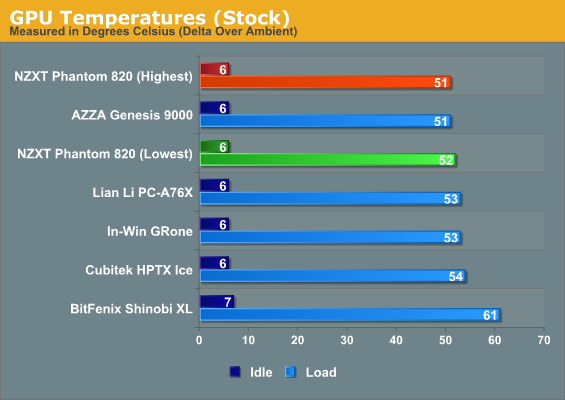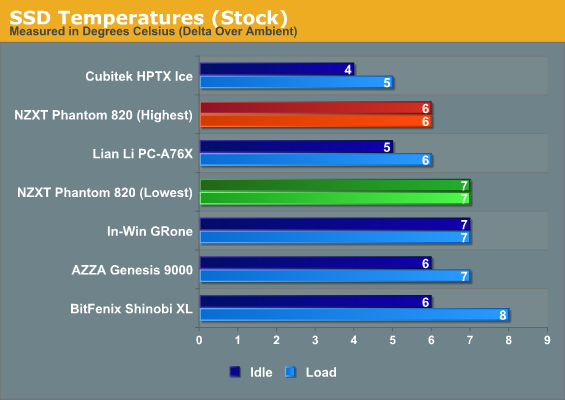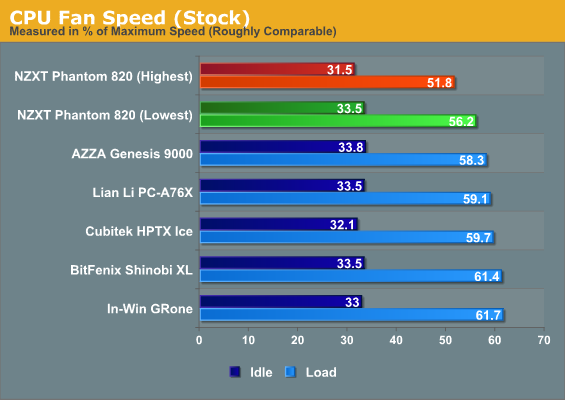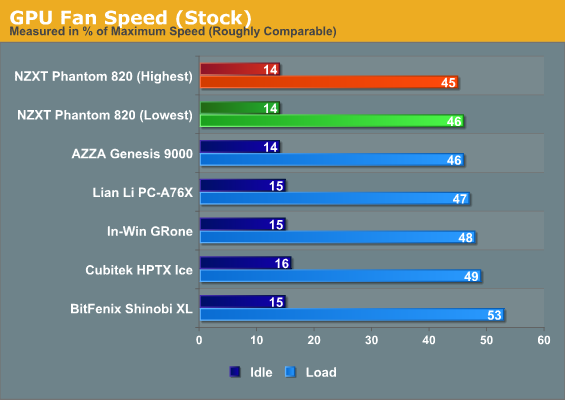NZXT Phantom 820 Case Review: Everything, Everything
by Dustin Sklavos on October 15, 2012 1:35 AM EST- Posted in
- NZXT
- Cases/Cooling/PSUs
- ATX
- E-ATX
Noise and Thermal Testing, Stock
While I was greatly enamored with the sheer number of features the NZXT Phantom 820 had and even somewhat impressed with the looks, I was substantially more ambivalent about cooling performance. The 820's thermal design is at least superficially very traditional, although the use of three 200mm fans calls to mind Rosewill's spectacular budget offering, the Thor v2.
It would've been onerous to test the Phantom 820 at all of its fan settings (the first fan setting is just "off"), especially keeping in mind that the individual channels (top, front, back, and side) are all individually configurable, so I tested it with the fans all at their highest setting and at their lowest setting above "off" with the intent of going back to retest at a median setting if it seemed appropriate. As you'll see, it did not.
All testing was done with an ambient temperature between 24C and 25C.



As you can see, out of the enthusiast cases we've tested so far, the NZXT Phantom 820 offers some of the best thermals in our stock configuration. Better, you can see that while the highest fan setting can improve thermal performance somewhat, it doesn't really need to.


Running the Phantom 820's fans at full speed gives you a little more headroom on the CPU cooler, but it looks like the side intake doesn't really need to run any faster than the lowest speed to do the job on our GeForce GTX 560 Ti.

Noise levels are also generally exemplary, where even the highest fan setting is still pretty tolerable. The PC-A76X may run slightly quieter, but it's also slightly warmer. There's an even trade-off here.
I'll admit when I first started actually testing the Phantom 820 I was impressed with just how quiet the case was, and again when I checked the thermals. NZXT has been pretty hit and miss when it came to performance, but the 820 is definitely in a league of its own. I was eager to see how it would handle the substantially increased thermal load of our overclocked testbed.










24 Comments
View All Comments
puppies - Monday, October 15, 2012 - link
I actually disagree with just about everything you said in your post.No 40 year old business professional is going to be seen dead with this case, it is a "gamer" case through and through.
I wouldn't touch aluminium if that is what you class as a "premium" material. It serves no measurable benfit over steel in my eyes and is more easily damaged, i'm sure the case designers looked at various materials when they went through the R+D for this case and may take on board the comments made about the drive trays being too flimsy but simply calling plastic and steel "crap" is laughable.
As for the price demanding a premium case, did you see the thermal and acoustic test results. It justifies itself there without a shadow of a doubt.
glugglug - Monday, October 15, 2012 - link
You mentioned there is a control for the color of the LED accent lighting. Is it possible to rewire the case to have the different LED colors act as different drive activity lights?Twoboxer - Monday, October 15, 2012 - link
Thanks for the fine case reviews. They are invaluable.In your article you mention the Thermaltake Level 10 GT, Corsair Obsidian 800D, and SilverStone FT02 as the "standards" for comparison, but you do not include performance data for them. I don't recall if they were done prior to establishing the current test bed, or if the results are available elsewhere on the web site.
But in any case it would be beneficial to include their results in at least some of tables presented, even if it means repeating those tests using the current test bed.
Astarael - Monday, October 15, 2012 - link
Agreed, and the Rosewill Thor v2 was also mentioned and would be nice to have in the comparison (given that it's so much cheaper, a useful cost/benefit analysis could be done).Dustin Sklavos - Monday, October 15, 2012 - link
They were done using the previous testbed. I generally avoid keeping cases around any longer than I have to as they occupy a LOT of space.Sugarfoot - Monday, October 15, 2012 - link
I have been looking to replace my HAF-X for a year now.Switch 810 almost did it, but since I dont have plans for watercooling for the foreseeable future, I wanted the Switch but with a side intake, as air cooled setups really love that. Plus the front panel's corner mesh was not dust filtered and I am quite keen on keeping my system dust free. (I use demciflex on my HAF)
I thought this case would be exactly it. Finally dethrone the HAF. Turns out not so. Not for me anyway, as ghastly as the HAF-X looks like, this one is even worse. Looks WAY too cheap and "gamer" to me.
Oh well, maybe there will be a Fractal Define R4 XL?
GeorgeH - Monday, October 15, 2012 - link
So, what's the conversion between ? and inches?glugglug - Monday, October 15, 2012 - link
235mm x 650mm x 612mm (W x H x D)http://www.hitechlegion.com/reviews/cases/31207-ph...
superflex - Monday, October 15, 2012 - link
For $249, I'll take an all aluminum Lian Li.spamreader1 - Monday, October 15, 2012 - link
the cables can't be seen from the motherboard side. I noticed this after I saw the completed install.